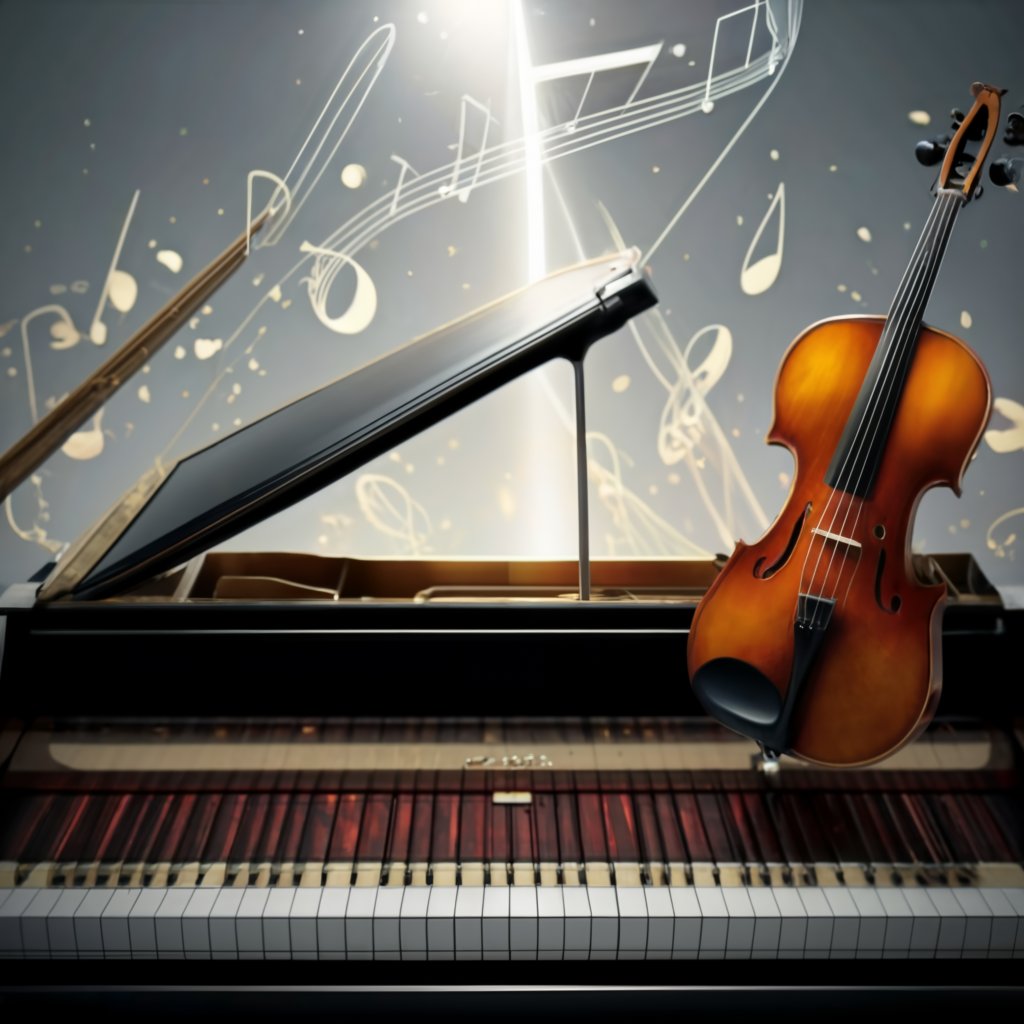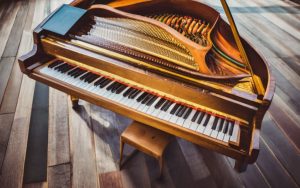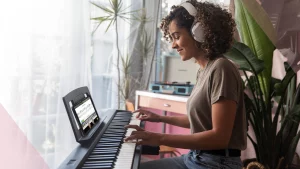Choosing between the piano and the violin can be a difficult decision for many students. Each instrument offers its own interesting and unique challenges and benefits.
In this article, we will explore the piano vs violin and examine what sets these two instruments apart. From their individual characteristics, challenges, and the distinct musical experiences they offer, we will uncover it all.
So, whether you admire the resonant beauty of piano chords or the powerful and emotional melodies of the violin, let’s check out the nuances of each instrument so you can make the best choice for your creativity.

Piano vs. violin: understanding the instruments
Understanding the fundamental difference between piano and violin is crucial. Each instrument presents distinctive challenges and unique characteristics for the musician.
Characteristics of piano and violin sounds
The piano produces sound via a hammer striking strings. This results in a wide dynamic range and the ability to produce multiple notes at once called chords.
This allows for rich harmonies and complex textures. The violin, on the other hand, is a bowed string instrument known for its expressive tone and vibrato capabilities, offering a more direct and intimate sound.
Role of piano and violin in classical and contemporary music
The piano and violin play important roles in both classical and contemporary music. The piano is a versatile solo instrument and an important foundation of many ensembles and the orchestra.
The violin is celebrated for its lyrical qualities and ability to convey emotion, often taking the lead in orchestral and chamber music settings. Together, they form a powerful duo in piano and violin duets, showcasing a blend of harmonic richness and melodic expressiveness.
Discovering musical pathways
The piano
The piano is an inviting gateway to music for many late beginners. The simplicity of the piano keyboard layout is accessible and clear.
The initial progress on this instrument can be rewarding, with melodies springing to life with each press of the keys. Hand coordination, while important, can be cultivated with a sense of grace. The piano is a canvas where musical expressions flow freely, and late beginners can find a muse that whispers melodies from their souls.
The violin
Conversely, the violin presents a more intricate and beguiling path for late beginners. It is an instrument that demands a deep connection between the player and the music. The initial challenges of producing sweet and resonant sounds can be formidable, as bowing techniques and finger placement require precision. However, within these challenges lies the allure of the violin.
Its enchantment is found in the pursuit of perfect intonation, a journey that demands dedication and a discerning ear. The violin invites late learners to explore the nuances of each note, to paint their emotions with the subtlest of strokes, and to craft melodies that resonate with the deepest parts of their being. It is an instrument of elegance and complexity, offering a musical odyssey filled with passion and resonance.
The art of piano and violin duets
There is a rich history of collaboration between the piano and the violin in the form of piano and violin duets. These duets are not just two instruments playing together; they are conversations between contrasting yet complementary voices. The piano, with its broad range and harmonic depth, provides a lush backdrop to the violin’s expressive and lyrical melodies. Together, they create a balance of power and delicacy, a dance of sound that can only be achieved through this unique pairing.
History and evolution of piano and violin duets
The history of piano and violin duets extends far back into the history of classical music. In the classical era, composers like Mozart and Beethoven crafted sonatas for piano and violin that remain cornerstones of the repertoire. These compositions set the stage for a dynamic interplay between the two instruments, exploring the contrast and harmony of their sounds. As music evolved, so did the nature of these duets, with romantic composers like Brahms and Franck adding layers of emotional depth and complexity.
Famous piano and violin duets to explore
Many great examples of piano and violin duets can be found in the history of classical music. Beethoven’s “Spring” Sonata is a celebration of lyrical beauty and joyful energy, while Franck’s Sonata in A major for Violin and Piano is a journey through lush, romantic landscapes. More contemporary works, like Ravel’s Sonata for Violin and Piano, bring a modern twist to the duet, blending impressionistic colors with bold, innovative harmonies.
The synergy in violin and piano duets
The beauty of a musical duet is found in the transparent integration of two unique musical voices. This combination is not just about the notes played; it’s about how the piano and violin interact, respond, and converse with each other, creating a musical dialogue that is greater than the sum of its parts.
How piano and violin complement each other in duets
In a piano and violin duet, the piano often lays down the harmonic foundation and sets the framework for the violin to convey its strong and lyrically expressive melodies. This combination allows for a diverse range of musical expressions, from delicate and intimate passages to powerful and dramatic crescendos. The piano’s ability to sustain chords and create a layered sound complements the violin’s capacity for sustained notes and emotive phrasing.
Analyzing famous duets: a closer look at composition and technique
The intricacies of composition and technique are part of what makes these iconic piano and violin duets so interesting. For instance, in the “Kreutzer” Sonata by Beethoven, the piano and violin engage in an energetic and intricate dialogue, pushing the boundaries of both instruments. In contrast, the violin and piano duet in Saint-Saëns’ “Introduction and Rondo Capriccioso” showcases a playful and virtuosic interplay, highlighting the agility and expressiveness of both instruments.
Mastering piano and violin duets
Achieving and performing piano and violin duets requires much more than strong instrumental skill. It also requires a strong understanding of how the two instruments work together in collaboration. This mastery is not a fairy tale; it’s a realistic goal achieved through dedicated practice and a keen sense of musical communication.
Tips for successful collaboration in duets
Successful collaboration in piano and violin duets hinges on several key factors. Firstly, both musicians must be attuned to each other’s timing and rhythm, ensuring a cohesive performance. Effective communication, both verbal and non-verbal, is crucial during rehearsals to align interpretative ideas. Additionally, understanding the strengths and limitations of each instrument allows for arrangements that showcase both the piano and violin effectively.
Techniques for blending piano and violin sounds
Blending the sounds of the piano and violin in a duet involves a delicate balance. The piano player should be mindful of the instrument’s volume and sustain, ensuring it doesn’t overpower the violin.
Conversely, the violin player should focus on phrasing and articulation to complement the piano’s harmonies. Techniques such as dynamic shading, tempo adjustments, and expressive articulation are essential tools for creating a harmonious and unified sound.
Piano and violin: a comparative study
The piano vs violin is ultimately a study of contrast and similarity. Each instrument makes use of the same basic materials, albeit in its own unique and challenging way. This comparative study not only enlightens aspiring musicians but also enriches the appreciation for these instruments.
Physical and technical aspects of playing piano and violin
The physical nature of the piano and the violin are vastly different. Playing the piano involves a coordination of both hands playing different keys, often simultaneously, requiring a sense of rhythm and spatial awareness. The violin, however, demands a precise control of bowing techniques and finger placement on the strings, with a significant emphasis on posture and arm movement.
Piano vs violin difficulty: a detailed analysis
When exploring the piano vs violin it is important to consider all the factors. For beginners, the piano might seem more approachable due to its straightforward note production – press a key, and a note sounds.
The violin, with no frets to guide finger placement and the need for bow control, can present a steeper initial learning curve. However, as one progresses, the complexity of playing multiple notes and chords on the piano can become challenging, while the violin players might find mastering advanced techniques and expressive playing equally demanding.
Is piano or violin harder?
To wonder whether “piano or violin is harder” is a common question among musicians. Both instruments have unique challenges, and the difficulty can be subjective, depending on the individual’s natural inclinations and learning style.
Challenges faced by beginners
For beginning students, the piano offers the unique challenges of coordinating both hands with different and often contrasting rhythms and harmonies. Understanding and reading piano music, which involves two staves, can also be daunting initially. In contrast, beginners on the violin face hurdles in producing a clear tone, as it requires precise finger placement and bow control, skills that take time and patience to develop.
Piano vs violin for intermediate and advanced players
As you develop as a pianist or violinist, the learning curves begin to diverge. Advanced piano players must master complex pieces that demand intricate finger work, pedal use, and dynamic control.
For violin players, the challenges lie in perfecting intonation, advanced bowing techniques, and the ability to express nuanced emotions through the instrument. Both instruments require dedication and practice, but the nature of their challenges varies significantly.
Final thoughts on piano vs violin
Later beginners face a choice about which instrument to learn. Choosing between piano and the violin can be a difficult decision. Each instrument offers a distinct journey, filled with its own set of challenges and rewards. The piano, with its accessible keyboard and harmonious melodies, invites late starters to explore a world of immediate gratification and artistic expression. On the other hand, the violin’s intricate bowing techniques and pursuit of perfect intonation beckon those seeking a more profound and soulful connection with music.
Understanding the characteristics and qualities of each instrument is crucial. The piano, a percussive string instrument, boasts a wide dynamic range and the ability to play multiple notes at once. In contrast, the violin, a bowed string instrument, offers an intimate and expressive tone, making it a vessel for emotional storytelling.
Ultimately, the choice between piano and violin lies in personal passion and musical aspirations. Whichever path you choose, the world of music awaits, ready to embrace your unique artistic journey.
Author of this blog post:
Susana Pérez Posada

With over seven years in piano education and a deep passion for music therapy, Susana brings a unique blend of expertise to Skoove. A graduate in Music Therapy from SRH Hochschule Heidelberg and an experienced classical pianist from Universidad EAFIT, she infuses her teaching with a holistic approach that transcends traditional piano lessons. In her writings for Skoove, Susana combines her rich musical knowledge with engaging storytelling, enriching the learning experience for pianists of all levels. Away from the piano, she loves exploring new places and immersing herself in a good book, believing these diverse experiences enhance her creative teaching style.
Edited and fact checked by Eddie Bond, multi-instrumentalist performer, composer, and music instructor
Published by Lidya Hovan from the Skoove team














